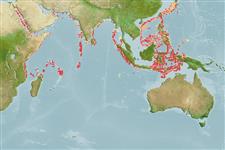Environment: milieu / climate zone / depth range / distribution range
Ekologi
laut bentopelagis; kisaran kedalaman 250 - 350 m (Ref. 6181). Deep-water; 31°N - 14°S, 32°E - 139°E (Ref. 6181)
Western Indian Ocean: Red Sea and west coast of India. Western Pacific: Timor Sea. This species has long been synonymized with Trichiurus lepturus.
Size / Weight / umur
Maturity: Lm ? range ? - ? cm
Max length : 42.4 cm TL jantan/; (Ref. 6181); common length : 23.0 cm TL jantan/; (Ref. 6181)
Duri punggung (Keseluruhan (total)) : 3; duri punggung lunak (Keseluruhan (total)) : 106 - 116; Sirip dubur lunak: 80. Body extremely elongate, compressed and tapering to a point. Mouth very large with a small dermal process at the tip of each jaw. Pelvic and caudal fins absent. Lateral line originating at the upper margin of the gill cover, running obliquely to behind the tip of the pectoral fins, then parallel to the ventral contour of the body. Fresh specimens are pearl white and slightly dusky dorsally; the margins of the dorsal and anal fins dusky in formalin.
Found in deep waters off Kerala and Tamil Nadu, India. Feeds on deep water shrimps and small fishes like myctophids and gonostomatids. Caught with deep water trawls mixed together with other commercially important fish as bycatch.
Life cycle and mating behavior
Kematangan | Reproduksi, perkembang biakan | Pemijahan | telur-telur | Fecundity | Larva
Nakamura, I. and N.V. Parin, 1993. FAO Species Catalogue. Vol. 15. Snake mackerels and cutlassfishes of the world (families Gempylidae and Trichiuridae). An annotated and illustrated catalogue of the snake mackerels, snoeks, escolars, gemfishes, sackfishes, domine, oilfish, cutlassfishes,. scabbardfishes, hairtails, and frostfishes known to date. FAO Fish. Synop. 125(15):136 p. (Ref. 6181)
Status IUCN Red List (Ref. 130435: Version 2024-2)
ancaman kepada manusia
Harmless
penggunaan manusia
Perikanan: tidak ada kepentingan
Alat, peralatan
laporan khas
muat turun XML
Sumber internet
Estimates based on models
Preferred temperature (Ref.
123201): 11 - 21.8, mean 12.2 °C (based on 49 cells).
Phylogenetic diversity index (Ref.
82804): PD
50 = 0.5020 [Uniqueness, from 0.5 = low to 2.0 = high].
Bayesian length-weight: a=0.00191 (0.00078 - 0.00466), b=3.12 (2.91 - 3.33), in cm total length, based on LWR estimates for this (Sub)family-body shape (Ref.
93245).
Trophic level (Ref.
69278): 4.2 ±0.73 se; based on food items.
Daya lenting (Ref.
120179): Rendah, Waktu penggandaan populasi minimum 4.5 - 14 tahun (Assuming tmax>10).
Fishing Vulnerability (Ref.
59153): Low to moderate vulnerability (32 of 100).
Nutrients (Ref.
124155): Calcium = 167 [42, 435] mg/100g; Iron = 0.939 [0.262, 3.001] mg/100g; Protein = 17.7 [15.9, 19.6] %; Omega3 = 0.285 [0.122, 0.695] g/100g; Selenium = 57.5 [16.1, 220.8] μg/100g; VitaminA = 5.47 [0.58, 46.73] μg/100g; Zinc = 0.834 [0.382, 1.501] mg/100g (wet weight);
